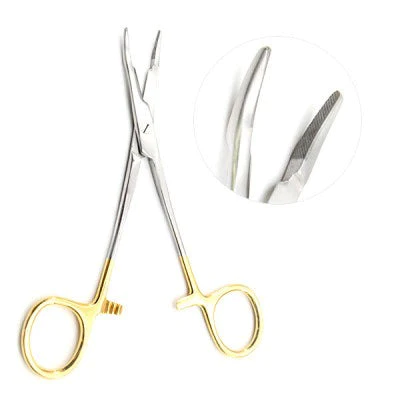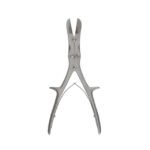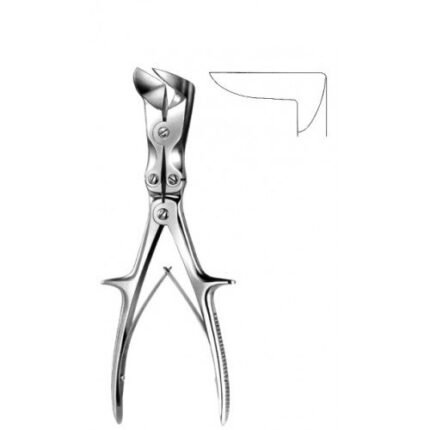Rongeur Bone cutting forceps/ Stainless Steel
Crafted from premium stainless steel for corrosion resistance and long-lasting performance, they offer a comfortable grip and reliable strength for both professional and clinical use.
Category: BONE HOLDING, CUTTING FORCEPS AND BONE RONGEURS
Tags: BoneCuttingForceps, BoneCuttingTools, BoneForceps, BoneSurgeryInstruments, DurableSurgicalInstruments, HighQualityForceps, ListonBoneCuttingForceps, ListonForceps, MedicalBoneCutters, OrthopedicInstruments, OrthopedicSurgery, OrthopedicSurgicalTools, OrthopedicTools, PrecisionForceps, ProfessionalBoneCutters, ReliableOrthopedicInstruments, StainlessSteelForceps, SurgicalBoneCutters, SurgicalEquipment, SurgicalInstruments
Description
Description:
Rongeur Bone Cutting Forceps
Rongeur bone cutting forceps are specialist surgical tools used to remove or shape bone during orthopedic, neurosurgery, and maxillofacial surgeries. These tools are essential for precision bone cutting and tissue removal, resulting in a satisfactory surgical outcome with little harm to the surrounding tissues. These forceps, which are often made of high-quality stainless steel, are durable, corrosion-resistant, and easy to sterilize, making them perfect for the demanding environment of surgical operations.
Key Features of Rongeur Bone Cutting Forceps
1. Design and Construction
Rongeur bone cutting forceps have ergonomic handles and robust jaws capable of clamping and removing bone fragments. These forceps have sharp, cutting edges that can safely cut through bone without causing injury to surrounding structures. The stainless steel structure provides strength and dependability, guaranteeing that the instrument can survive the rigors of repeated use.
2. Tip Design
Rongeur forceps have several tip configurations, including straight, curved, and cone-shaped tips. The particular tip design allows surgeons to adjust their approach to the patient’s surgical demands. For example:
- Straight Rongeurs are commonly utilized for more direct and uncomplicated bone removal.
- Curved Rongeurs are great for accessing and cutting bone in difficult-to-reach regions.
- Cone-Shaped Rongeurs give more precision, and are frequently utilized in neurosurgery to remove tiny bone fragments.
3. Stainless Steel Material
It is important that these forceps be made of stainless steel. Stainless steel is a great material for surgical instruments because of:
- Corrosion Resistance: Because stainless steel doesn’t rust or corrode, the instrument will last for a long time even after being exposed to numerous sterilization treatments.
- Strength and Durability: Stainless steel’s toughness guarantees that the forceps will stay sharp for extended periods of time, allowing for accurate bone cutting without dulling.
- Biocompatibility: Because stainless steel doesn’t react with human flesh, there is a lower chance of allergic responses or other surgical complications.
Applications of Rongeur Bone Cutting Forceps
In many surgical procedures, rongeur bone cutting forceps are indispensable, particularly when exact bone removal is required. Among the most important uses are:
1. Neurosurgery
When access to the brain is needed during neurosurgical procedures, such as craniotomies, rongeur forceps are used to remove small pieces of bone. These tools allow surgeons to gently remove bone fragments while causing the least amount of harm to the surrounding brain tissue. During spinal procedures or when getting ready for implantations, the forceps can also be used to scrape away bone pieces or debris.
2. Orthopedic Surgery
These forceps are essential for removing or shaping bone during orthopedic procedures. Rongeur forceps are frequently used by surgeons for operations like joint replacements, spinal fusions, and bone spur removal. With the help of the forceps, surgeons may precisely remove bone fragments and reach hard-to-reach places.
3. Maxillofacial Surgery
In maxillofacial surgery, rondeur forceps are frequently used to reshape the jaw, remove bone fragments following trauma, or perform reconstructive procedures. When eliminating parts of the facial skeleton, they are especially helpful in producing smooth bone surfaces.
4. Trauma Surgery
Rongeur bone cutting forceps enable surgeons to securely remove broken bone fragments in trauma cases where prompt action is necessary due to bone fractures. In decompression treatments, where bone or tissue must be removed to relieve pressure on surrounding tissues, the forceps can also be utilized.
Types of Rongeur Forceps
There are several types of rongeur forceps, each suited to different surgical needs. These include:
- Single-Action Rongeurs
These are usually utilized for softer bones and have a single hinge mechanism. They are perfect for delicate surgery because they are lightweight and manageable. - Double-Action Rongeurs
The double hinge mechanism of these forceps increases cutting force. When additional force is needed or for harder bones, double-action rongeurs are usually employed. - Cylindrical and Bayonet Rongeurs
Bayonet-style rongeurs are made to reach into confined or difficult-to-reach surgical locations, whereas cylindrical rongeurs are usually employed for larger bone removal.
Benefits of Using Rongeur Bone Cutting Forceps
1. Precision
The ability of Rongeur forceps to cut bone precisely is essential for procedures like neurosurgery and joint replacements where precision is crucial.
2. Efficiency
With the use of these instruments, surgeons may efficiently remove bone without applying undue stress. Their cutting edges are made to securely grasp the bone, guaranteeing effective extraction.
3. Safety
By providing surgeons with better control over bone removal, rongeur bone cutting forceps help to minimize trauma to surrounding tissues and structures, thus improving patient safety and recovery outcomes.
4. Versatility
Because they can be used for a wide range of treatments, including dental or maxillofacial surgery, cranial procedures, and spinal surgeries, Rongeur forceps are incredibly versatile.
Care and Maintenance
The following upkeep and care are necessary to guarantee the durability and functionality of rongeur bone cutting forceps:
1. Regular Cleaning and Sterilization
These tools should be carefully cleaned and sterilized using conventional techniques, including autoclaving, after every use. Although stainless steel is resistant to corrosion, it should still be carefully maintained to avoid rust or residue accumulation.
2. Inspections for Wear and Tear
Surgeons should routinely check the forceps for deterioration, such as loose hinges or dull cutting blades. Ineffective cutting might result from dull tools, raising the patient’s risk of damage.
3. Proper Storage
The forceps should be kept in a dry, sterile environment, away from harsh chemicals and high humidity, to preserve their integrity and sharpness.
Conclusion
Due to their strength, accuracy, and dependability, stainless steel rondeur bone cutting forceps are vital tools for modern surgery. These forceps allow for the safe and efficient removal of bone in orthopaedic, neurosurgery, or maxillofacial surgery procedures. These instruments will be a vital part of a surgeon’s toolbox for many years to come because of the rongeur’s distinctive design and the durability of stainless steel. Proper use and maintenance of these equipment facilitates better surgical outcomes, reduced recuperation periods for patients, and increased overall safety.
Reviews (0)
Be the first to review “Rongeur Bone cutting forceps/ Stainless Steel” Cancel reply
Shipping & Delivery


MAECENAS IACULIS
Vestibulum curae torquent diam diam commodo parturient penatibus nunc dui adipiscing convallis bulum parturient suspendisse parturient a.Parturient in parturient scelerisque nibh lectus quam a natoque adipiscing a vestibulum hendrerit et pharetra fames nunc natoque dui.
ADIPISCING CONVALLIS BULUM
- Vestibulum penatibus nunc dui adipiscing convallis bulum parturient suspendisse.
- Abitur parturient praesent lectus quam a natoque adipiscing a vestibulum hendre.
- Diam parturient dictumst parturient scelerisque nibh lectus.
Scelerisque adipiscing bibendum sem vestibulum et in a a a purus lectus faucibus lobortis tincidunt purus lectus nisl class eros.Condimentum a et ullamcorper dictumst mus et tristique elementum nam inceptos hac parturient scelerisque vestibulum amet elit ut volutpat.
Related products
Adson Bone Rongeurs 21CM
Castleimpexx Manufacturing and Supplying Excellent Quality Bone Holding, Cutting Forceps and Bone Rongeurs, such as Adon Bone Ronguers, Beyer Bone Ronguers, Echlin Bone Ronguers, Gerster Lowman Bone Holder 18 Cm, Gerster Lowman Bone Holder 18 Cm, Geiger Bone Ronguers, Hartmann Bone Rongurers, Jansen Bone Ronguers, Kern Bone Holding Forceps, Lane Bone Holding Forceps, Listen Bone Cutting Forceps Angular, Leksell Bone Rongeurs, Luer Bone Ronguers, Ruskin Bone Ronguers, Stille Bone Ronguers, Ulrich Bone Holding Forceps, Van Buren Bone Holding Forceps and Wish Bone Holding Forceps.
Beyer Bone Rongeur 17 cm
Castleimpexx Manufacturing and Supplying Excellent Quality Bone Holding, Cutting Forceps and Bone Rongeurs, such as Adon Bone Ronguers, Beyer Bone Ronguers, Echlin Bone Ronguers, Gerster Lowman Bone Holder 18 Cm, Gerster Lowman Bone Holder 18 Cm, Geiger Bone Ronguers, Hartmann Bone Rongurers, Jansen Bone Ronguers, Kern Bone Holding Forceps, Lane Bone Holding Forceps, Listen Bone Cutting Forceps Angular, Leksell Bone Rongeurs, Luer Bone Ronguers, Ruskin Bone Ronguers, Stille Bone Ronguers, Ulrich Bone Holding Forceps, Van Buren Bone Holding Forceps and Wish Bone Holding Forceps.
Farabeuf Lambotte Bone Holding Orthopedic Surgical Instruments
Kern Bone Holding Forceps 6″ with Ratchet – Orthopedic Surgical Instruments
- Kern Bone Holding Forceps: The Premium Quality Rizbain Surgical Kern Bone Holding Forceps measure 6" long and are designed to be a exceedingly versatile instrument for a wide variety of orthopedic .
- Made Of Durable Stainless Steel: Forged from corrosion resistant stainless steel for superior quality, durability and long life.


































Reviews
There are no reviews yet.